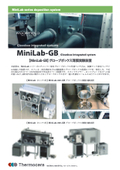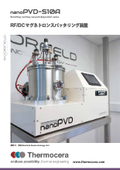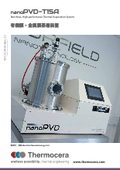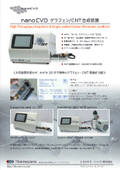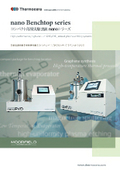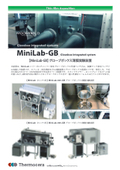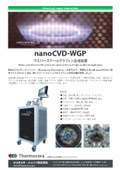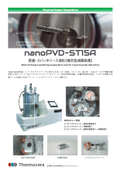Sputtering device "MiniLab series"
Due to its modular embedded design, it is possible to flexibly assemble dedicated equipment according to the required film deposition method. A compact thin-film experimental device that can accommodate various research applications.
**Flexible System** The MiniLab thin film experimental device series allows for easy construction of a compact system without waste, even as a customized product, by incorporating suitable components (such as deposition sources and stages) and control modules according to the required deposition methods and materials from a wide range of options. By configuring the device with a modular control unit in a Plug&Play manner, the application range expands, enabling various thin film process experiments. The MiniLab series is a high-cost performance system that caters to a wide range of applications from research and development to small-scale production. **Small Footprint & Space-Saving** - Single Rack Type (MiniLab-026): 590(W) x 590(D)mm - Dual Rack Type (MiniLab-060): 1200(W) x 590(D)mm - Triple Rack Type (MiniLab-125): 1770(W) x 755(D)mm **Excellent Operability & Intuitive Operation Screen** Windows PC or 7” touch panel. Easy operation that does not require advanced skills, while ensuring maximum safety.
basic information
【MiniLab Flexible Thin Film Experimental Device Configuration Modules】 ◉ Manufacturing Range Resistance Heating Deposition (TE), Organic Film Deposition (LTE), Electron Beam Deposition (EB), RF/DC Sputtering (SP), T-CVD/PE-CVD, Plasma Etching (RIE) ◉ Chambers ・026 (26 Liters) - TE/LTE/SP/CVD/Etch/*Globe Box option: Max Φ6 inch ・060 (60 Liters) - TE/LTE/EB/SP/Etch/: Max Φ8 inch ・080 (80 Liters) - TE/LTE/EB/SP/Etch/: Max Φ10 inch ・090 (90 Liters) *Globe Box option - TE/LTE/EB/SP/Etch/: Max Φ10 inch ・125 (125 Liters) - TE/LTE/EB/SP/Etch/CVD: Max Φ12 inch * For other specifications, please refer to our website.
Price information
Please feel free to contact us.
Delivery Time
Applications/Examples of results
Main uses: - Development of new materials - Advanced technology development - Small-scale prototype production etc.
Detailed information
-

MiniLab-026-TE/LTE/SP The smallest model in the MiniLab series, a standalone thin film experimental device with a 19-inch single rack frame. It has a compact size requiring a minimum installation space of 600mm in width and 600mm in depth, allowing for TE (resistive heating evaporation), LTE (organic thin film evaporation), and SP (sputtering) experiments. Despite its small size, it features PID automatic loop film deposition control (manual operation is also possible) and can perform simultaneous deposition.
-

MiniLab-026-GB (Glove Box Storage Type) A glove box model with the MiniLab-026 chamber installed in the workbench and the control unit stored underneath the bench.
-

MiniLab-026 Etch/Anneal Station A device equipped with an RF dry etching stage and a substrate heating stage in the MiniLab-026 chamber. There are two models: a standalone version housed in a MiniLab series 19-inch rack frame and a variant stored in a glove box, the MiniLab-026-GB. This product is a collaborative development with the University of Manchester's Graphene Group. It contributes to the development of TMDC and 2D materials through a unique RIE system that operates at under 30W, offering low damage and excellent control precision.
-

MiniLab-060-TE/LTE/EB/Sputtering Device The "MiniLab-060" series is an R&D device that can be configured for a wide range of purposes, including TE (resistive heating evaporation), LTE (low-temperature organic film deposition), EB evaporation, and RF/DC magnetron sputtering, by incorporating a rich variety of components in a modular fashion. There are also many options available, such as vertical lift, substrate rotation, heating and cooling stages, and load lock. (The photo shows the EB model equipped with a 6 pockets evaporation source.)
-

The MiniLab-060 PECVD device is a semi-automatic plasma CVD machine equipped with up to four gas lines, RF/DC power units, and a substrate heating and rotating stage (max 1200°C). It features a high vacuum specification with a 60L volume chamber, equipped with RP (DP) + TMP, allowing for stable automatic control of vacuum and gas pressure through PLC/MFC. It is capable of conducting film deposition experiments on wafer sizes ranging from 1 to 8 inches.
-

MiniLab-080-TE/LTE/SP Box-type chamber: A higher model than the MiniLab-060, which can add a load lock mechanism to an 80-liter large chamber with a chamber height of 570mm. The longer T/S distance adjustment range contributes to improved film uniformity.
-

MiniLab-090 (*Glove Box Storage Type) This is a glove box model of the Mini-Lab-080, which features a large 80L chamber with dimensions of 400x400x570, stored within a workbench. It has a front-loading design with sliding doors, a maintenance door accessible from the back of the chamber, and is a space-saving, high-spec model that maximizes the use of the workbench despite the large chamber size. It can be used for various purposes such as vacuum deposition, sputtering, and RF etching. It allows for clean thin film experiments without exposing samples to the atmosphere or moisture after processing.
-

MiniLab-125 All options of the MiniLab series can be equipped in a large high-capacity chamber (500x500x600mm). It is the top-end model of the MiniLab series, covering applications from research and development to small-scale production. It offers a wide range of options such as a load lock system, automatic mask changer, and planetary dome.
Related Videos
catalog(37)
Download All Catalogs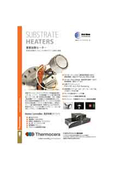
News about this product(8)
-

☆★☆【nanoETCH】Soft Etching Device☆★☆
<30W Low Power Control for Damage-Free Etching Achieves delicate etching processes with an output control precision of 10mW. A jointly developed product with the graphene research group at the University of Manchester, led by Nobel Prize winners who discovered graphene in 2010. 【Features】 • 2D (Transition Metal Chalcogenides, graphene delamination after material transfer): Surface modification cleaning • Removal of polymer resists such as PMMA and PPA • Surface modification and etching on substrates prone to damage, such as Teflon substrates • h-BN sidewall etching (*Option for "Fluorine Gas Supply Module," requires SF6 gas system) • SiO2 etching (*Option for "Fluorine Gas Supply Module," requires CHF3 gas system) 【Specifications】 ◉ Compatible substrates: Up to Φ6 inches ◉ Easy operation with a 7" touch panel and PLC automatic sequencing ◉ Automatic pressure control (APC) ◉ One Ar gas line (standard) + up to three additional lines for N2 and O2 ◉ Connects to a Windows PC with a USB port for automatic etching recipe creation and storage. Data logging on PC.
-
![Multisource Simultaneous Sputtering Device [MiniLab-S125]](https://image.mono.ipros.com/public/news/image/1/053/100513/IPROS09263764224142550225.jpeg?w=280&h=280)
Multi-Target Sputtering Device [MiniLab-125] Compatible with Φ8" SiC Coating Equipped with 1000℃ Heater Stage! Compact Size!
Multifunctional Multi-Sputtering Device (Compatible with Φ8inch Substrates) - Simultaneous deposition of three components + one component Pulse DC sputtering - Flexible arrangement of RF500W and DC850W power supplies to three cathodes (Source 1, 2, 3) - Equipped with a 5KW Pulse DC power supply → used with dedicated cathode (4) - Substrate heating stage Max 800℃ (SiC coated heater can achieve Max 1000℃) - MFC x 3 systems (Ar, O2, N2) for reactive sputtering - Main chamber RIE etching stage RF300W - LL chamber <30W low power controlled soft etching - Unique "Soft-Etching" technology reduces substrate damage through substrate bias - Touch panel or Windows PC operation: All operations can be performed on the touch panel/PC without dispersing control. - Equipment installation dimensions: 1,960(W) x 1,100(D) x 1,700(H) mm - Multi-chamber type can also be manufactured. ● Mixed specifications for resistance heating deposition, organic material deposition, EB deposition, PECVD, etc. are also possible.
-

The catalog for the MiniLab Flexible Thin Film Experimental Device has been renewed!
We have completely renewed the catalog for the MiniLab series thin film experimental equipment. 【Features of the MiniLab Series】 ◉ Supports sputtering, evaporation (resistive heating, organic, EB), annealing, plasma etching, etc. ◉ Modular design allows for flexible combinations of components (source hybrid types and multi-chamber configurations are possible) ◉ Compact, space-saving design (width 1,200 x depth 560 mm) ◉ Excellent operability: intuitive interface allows for centralized management of all operations via a touch panel without dispersion. We are confident that this will be of great assistance in research and development settings. Please consider it.
-

4-Yen Multi-Sputtering Device 【MiniLab-S060】
4 cathodes with Φ2 inch configuration Simultaneous film deposition: 3-component simultaneous deposition (RF 500W or DC 850W) + HiPIMS (PulseDC 5KW) x 1 Power distribution and configuration settings for 4 cathodes can be freely changed via the HMI screen using the plasma relay switch 3 MFC systems (Ar, O2, N2) for reactive sputtering RIE etching stage RF 300W (main chamber) + <30W soft etching (LL chamber) Substrate heating: Max 500℃, 800℃, or 1000℃ (C/C or SiC coating) Substrate rotation and vertical movement (automatically controlled by stepping motor) APC automatic control: Upstream (MFC flow adjustment) or downstream (automatic valve opening adjustment on the exhaust side) Dimensions: 1,120(W) x 800(D) ● Mixed specifications for resistance heating deposition, organic material deposition, EB deposition, PECVD, etc. are also possible.
-

【MiniLab】 Evaporation/Sputtering Dual Chamber System
Two thin film experimental devices are connected by a load lock mechanism. Different film deposition devices (sputtering - evaporation, etc.) are seamlessly connected via the load lock. With Moorfield's unique load lock system, connections to the process chamber on the left, right, and rear are also possible (see photo below). 1. MiniLab-E080A (Evaporation Device) - EB evaporation: 7cc crucible x 6 - Resistance heating evaporation x 2 - Organic evaporation limit x 2 2. MiniLab-S060A (Sputtering Device) - Φ2" Magnetron cathode x 4 for simultaneous sputtering - Compatible with both DC and RF power supplies 3. Load Lock Chamber - Plasma etching stage In the load lock chamber, plasma cleaning of the substrate surface is performed using the "RF/DC substrate bias stage," and the company's unique "soft etching" technology allows for a <30W low-power, damage-free plasma etching stage. This enables delicate etching processes that are prone to damage, such as 2D (removal of resists like PMMA), graphene delamination, and etching of Teflon substrates. (*This can also be installed in the main chamber stage.)
Recommended products
Distributors
【Endless possibility_thermal engineering...】 Our company sells vacuum thin film devices for semiconductor and electronic device fundamental research, ultra-high temperature heaters for CVD substrate heating, experimental furnaces, temperature measurement equipment, and more. To meet the endless demand for "heat," which is indispensable in any era, and to respond to various requests in the field of fundamental technology development, we aim to introduce the latest equipment and contribute to research and development in Japan.















